Every person who wants to lose weight begins to look for a magic set of exercises for weight loss: how to burn more, exercise less and not give up the usual sweets and fast food.
It is important to understand that playing sports for weight loss is a competent combination of physical activity and proper nutrition. As some trainers say, all training starts in the kitchen.
Today we will understand the intricacies of competent training, exercises and performance techniques, creating a typical training week and adjusting nutrition.
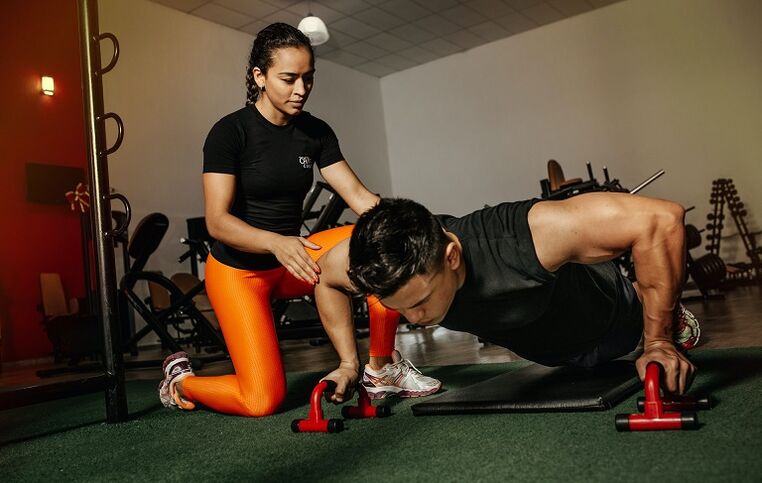
How to exercise for weight loss
There is no universal set of exercises that would suit everyone and that would guarantee weight loss in the shortest possible time. However, you can create your own plan structure, based on several key principles, and already in it choose those exercises that are more suitable, based on technical, physical and time possibilities.
What is recommended to pay attention to if the goal of training is to lose weight:
- Combine strength training and cardio. You're not on a mission to become a bodybuilder or a marathon runner, so you shouldn't go to extremes. Find a happy medium by spreading the workload evenly throughout the week.
- Alternate trainings of different directions. That way you will have enough time to recover the involved muscles - you can train more often and more. For example, if your plan is to run on Monday, do arm strength training on Tuesday and spin the bike on Wednesday.
- Do not exercise when you are tired. If you had a hard day at work, didn't get enough sleep, or had a long flight on a business trip, you don't have to go to an evening workout at any cost. Despite the supercompensation effect promoted by motivational videos (increasing the initial level of physical abilities after intense training), it will only work against the background of normal recovery, including nutrition and sleep.
- Adjust your diet to your workouts. You should not train on an empty stomach, especially if you do not have the appropriate experience, but you should not go to training immediately after breakfast. The optimal time for classes is two to three hours after eating.
- Interval training, in which periods of intense load alternate with short periods of rest or low-intensity exercises, are considered the most effective for burning fat. One option for interval training can be circuit training in the gym, in which intense strength exercises are alternated with short cardio training - jogging or brisk walking.
- Don't expect instant results. There is no need to weigh yourself every day and look at the deviations in grams, assessing progress. Untrained people usually need six to eight weeks to adapt to exercise, after which the fitness level allows for the addition of high-intensity exercise and longer workouts that burn more calories and fat.
- For a beginner, 300 minutes of moderate-intensity exercise per week will be sufficient. These include: brisk walking, running, cycling, swimming, strength training and circuit training in the gym, jumping rope, outdoor exercise equipment, walking on hills and trails. Spread the load evenly over the days. It could be five one-hour training sessions a week, or three one-hour sessions on weekdays and a long two-hour bike ride on the weekend.

A set of exercises for weight loss
Consider the average person who works a standard 5/2 schedule and only has the opportunity to train after work on weekdays as well as weekends.
Since athletic performance plays a secondary role in weight loss, you should not train on both weekends. Leave yourself a day for complete rest. Firstly, it is necessary to physically recover after the working week, and secondly, it will allow you to take a mental break from the training process, which will now permeate the weekly schedule in search of weight loss.
Examples of training weeks:
| Day of the week | Option 1 | Option 2 | Option 3 |
|---|---|---|---|
| Monday | Strength training in the gym | Strength training in the gym | Light cardio training |
| Tuesday | Light cardio training | Exercising outdoors | Strength training in the gym |
| Wednesday | Relaxation | Relaxation | Circuit training |
| Thursday | Strength training in the gym | Light cardio training | Relaxation |
| Friday | Circuit training | Strength training in the gym | Strength training in the gym |
| Saturday | Extended cardio | Relaxation | Extended cardio |
| Sunday | Relaxation | Extended cardio | Relaxation |
Strength training in the gym
Strength training, including resistance training, helps increase muscle tone, increase strength, and build muscle mass over time. Weights include dumbbells, dumbbells, barbells, expanders and various simulators.
Strength training is important because it allows you to maintain muscle mass and strength while shedding excess fat. They have also been shown to increase bone density, which in turn reduces the likelihood of developing osteoporosis with age.
Examples of effective exercises for burning fat in the gym:
Swing the kettlebell
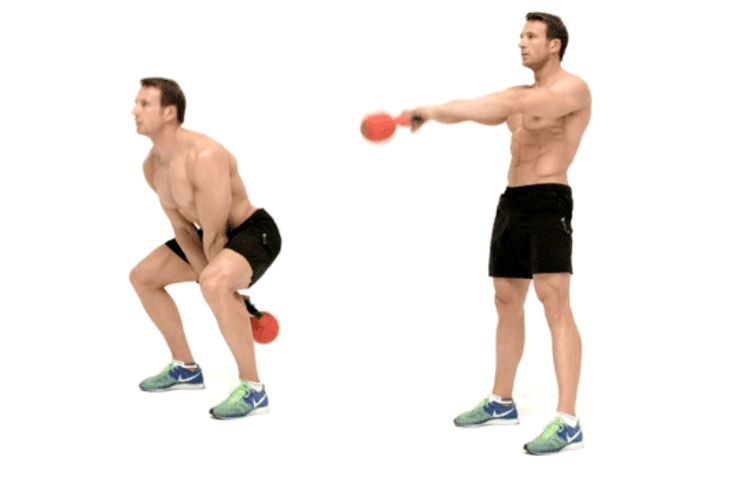
Kettlebell swings are fairly easy to learn and are one of the most effective fat-burning exercises because they work the glutes, hips, abs, back, arms and shoulders at the same time.
Technique:
Stand up straight with your feet slightly wider than your shoulders and your knees slightly bent. Hold the weight with both hands between your legs. Lean back slightly, straighten your legs at the same time and extend the kettlebell forward with straight arms. The weight itself will do the reverse movement. Your task is to bend your knees slightly and let them swing back. Each swing movement is made from the legs to the arms.
Typical errors:
- Do not round your back, it should be flat.
- Do not try to pull the kettlebell up. All swings are performed by inertia due to the movements given by the legs.
- Do not carry the kettlebell too far forward. This will put more stress on the shoulder joints and can lead to injury.
- Do not take too much weight. The point of the exercise is to involve a large number of muscles and technically correct execution, and not to lift significant weight.
Squats with dumbbells
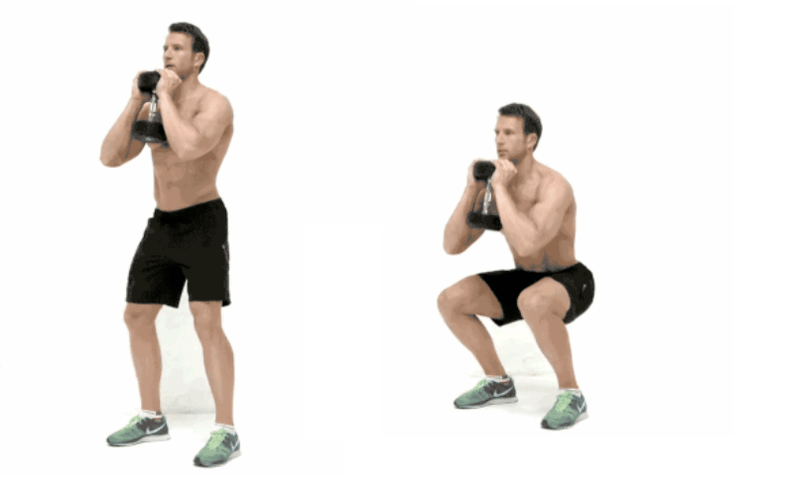
Squats are a basic exercise for leg development. If bodyweight squats are easy for you, but you're afraid to switch to barbell training, start with an easy option - dumbbell squats. This exercise, in addition to the legs, includes the back, abs and arms.
Technique:
Stand up straight. Legs slightly wider than shoulders. Grasp a dumbbell with both hands at one end and raise it to chest level. Start squatting until your thighs are parallel to the floor. Slowly raise yourself to the starting position. The feet must be stationary.
Typical errors:
- Heels off the floor. If you start jumping up and down to get to the starting position, then you have picked up a dumbbell that is too heavy.
- Don't round your back. Stay straight at the top and bottom.
Dumbbell or kettlebell overhead presses
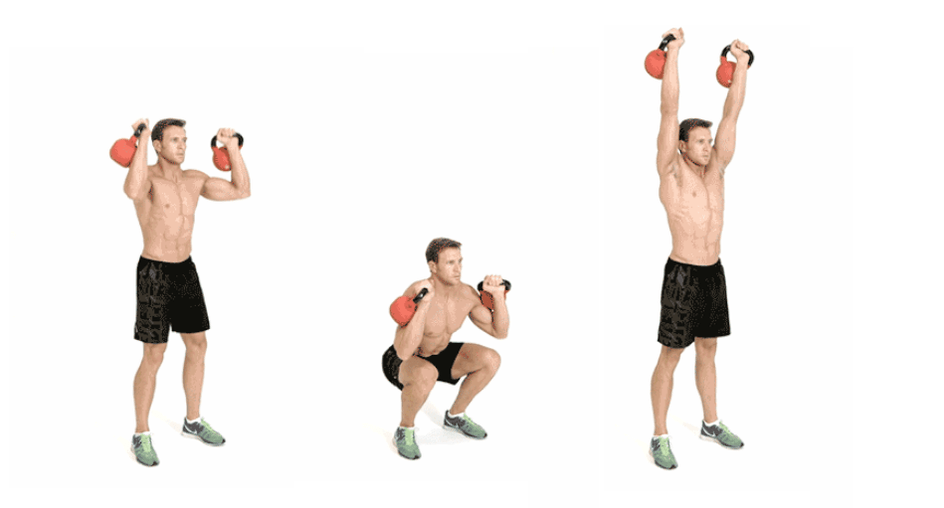
You can perform this exercise both statically and dynamically, combining the bench press with squats, which will allow you to burn even more calories and fat. In the dynamic version, almost all major muscle groups are included - buttocks, hips, back, abdominal muscles, arms, shoulders.
Technique:
Stand straight, feet slightly wider than shoulders. Grasp a dumbbell or kettlebell in each hand. Bend your elbows, the shells should be over your shoulders. Squat until your thighs are parallel to the floor. When you rise to the starting position at the top point, squeeze the dumbbells / kettlebells overhead. Return your hands to their original position.
Typical errors:
- Do not take shells that are too heavy. It is easy to get injured in dynamics, therefore, in the phase of getting used to and mastering the technique, it is better to work with the lightest dumbbells / kettlebells.
- Do not lift your heels off the floor, as this will compromise stability - you may lose balance due to the extra weight in your hands.
- Do not squeeze dumbbells/weights after standing up. Use the momentum you set up with your legs from the bottom point. All movements are performed dynamically, as in an exercise with a kettlebell swing.
farmer's walk
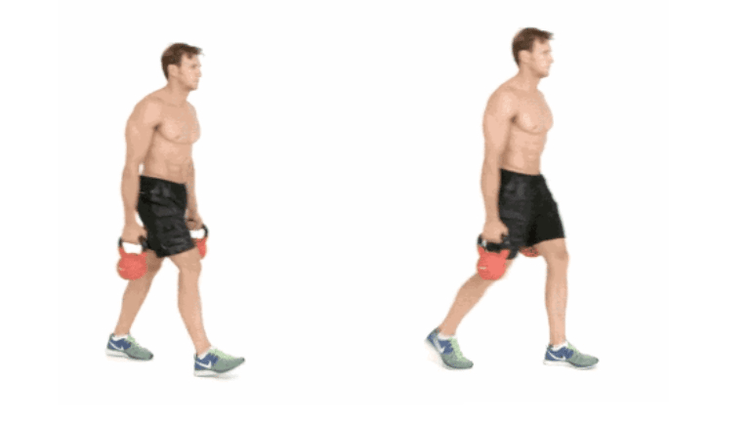
The farmer's walk is walking with weights. This exercise, due to the additional weight, increases the load on the legs, and also includes the shoulders, arms, back and abs.
First, take a pair of dumbbells or kettlebells with a total weight of 25-30% of your body weight and take 20-40 steps. If it's easy, you can add weights or make the exercise more difficult and do a lunge.
Dumbbell push
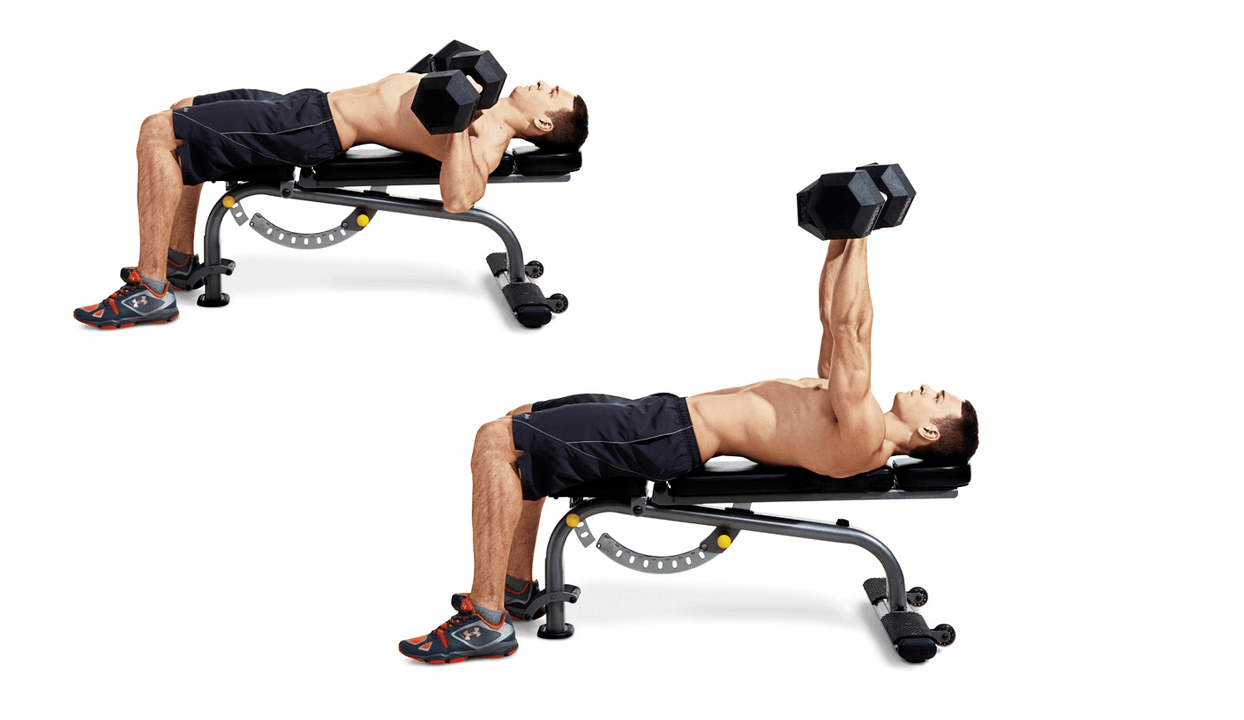
Bench press actively involves the upper body - pectoral muscles, shoulders, arms.
Technique:
Grab a dumbbell in each hand and lie on the bench. Spread your legs a little wider than your shoulders and press your heels firmly into the floor. Tighten your abdominal and back muscles. Push the dumbbells off your chest until your arms are straight. Slowly return them to their original position.
Typical errors:
- Do not relax your arms when lowering. This can lead to shoulder injury.
- Do not take dumbbells that are too heavy, as this also increases the rate of injury. You should be comfortable doing 8-12 reps per set.
Circuit training
The good thing about circuit training is that you can incorporate almost any exercise that you can do at a moderate or fast pace.
Main points to consider when planning circuit training:
- Alternate exercises for different muscle groups to alternately rest your arms, legs, back, and abs.
- The duration of the intense interval should not be longer than one minute, otherwise the exercise will turn into endurance work. It is important that you perform this interval at a fast or moderate (in the case of weight training) pace.
- The duration of low-intensity intervals (walking, running) or rest should not exceed 30 seconds.
- The total duration of training should be 15-20 minutes.
Examples of exercises:
- push-ups;
- hanging bent legs on a horizontal bar;
- squats;
- dynamic core exercises - climber, bicycle;
- stretching - jumping lunges with a change of legs;
- tilt dumbbell;
- swing weights;
- overhead dumbbell press;
- burpees;
- push-ups on uneven bars;
- box jumping;
- skipping rope;
- alternately lifting the legs into a plank.
Collect a block of four to eight exercises in one round. Each exercise is performed for 30-60 seconds with a 30-second rest. Rest between rounds – one to two minutes or a light jog if you exercise outside or the gym allows. Complete three to five rounds until the total exercise time approaches 15-20 minutes.
Light cardio training
Light cardio is a low to medium intensity workout that lasts no longer than an hour. For beginners, it is best to work for no more than 30 minutes until you feel that your cardiovascular system has adapted enough to train without holding your breath.
One of the indicators of cardiovascular fitness is the speaking test. If you can carry on a conversation while doing cardio, then the intensity of the load will allow you to train long enough.
Light cardio exercises include:
- jogging;
- pedaling an exercise bike or bicycle;
- stepper lessons;
- skipping rope;
- swimming;
- skiing.
Extended cardio
Long trainings differ from easy ones only in the time spent. Try to maintain the same intensity that allows you to complete the speaking test.
To combine work with pleasure, join a running club for a weekend run, cycle with friends in the countryside or go on long hikes over hills and rough terrain.
Typical errors:
- Don't start too fast. You don't have to do your best right away. Instead, start your run with a brisk walk and slowly transition into a run. When you ride a bike, don't climb a mountain right away, but ride for 10-20 minutes on a smooth road at an easy pace.
- Don't train strictly on time. Focus on your own feelings. There is no need to push yourself if you are tired.
- Don't forget to drink water or isotonic drinks, especially in summer. During prolonged exercise, the body loses fluid through sweat, so these losses must be compensated.
Exercise tips
- Every workout starts with a warm-up and ends with a cool-down. Warm-up is necessary to warm up the muscles and reduce trauma, rest - for smooth cooling and reduction of blood circulation in the body.
- Don't train the same way two days in a row. Let your muscles rest.
- If you can't do a certain exercise, replace it with a similar one. Instead of running, you can walk on a stepper, instead of dumbbells, do push-ups from the floor, instead of pull-ups, do pull-ups in the block simulator. The same muscle group can be loaded with a bunch of different exercises.
- Start with light weights and gradually increase the load. Linear progress is only in the beginning, then it will be more difficult for you to add weights, because it will take more time for the ligaments, tendons and muscles to adapt. Excessive zeal and the desire to shake the bar more can lead to serious injuries and a forced stoppage in training.
- If you feel very tired, take a break for two to three days to let your body recover. Periodically organize a load week, for example once a month, when the load is 50-75% of the usual. In a load week, you can remove one or two workouts or simply reduce the time of each session by 15-30 minutes.

Diet tips for weight loss
- Breakfast should be healthy and rich in slow carbohydrates: cereals, whole grain cereals, bananas. Carbohydrates are not only fuel for muscle work (carbohydrates from food are stored in the muscles and liver in the form of glycogen), but are also a source of glucose for normal brain function.
- Don't look for a quick fix in the trendy low-carb and keto (high-fat) diet. Follow the balance of protein (10-30%), fat (25-35%) and carbohydrates (45-65%) recommended by your doctor and adjust your diet according to how you feel.
- In order to lose weight, you need to be in a caloric deficit. This means you should spend a little more than you do. Consumption includes the average needs of the body for normal functioning, as well as calories consumed during training. Consumption should be evenly reduced to all components (proteins, fats and carbohydrates), and not at the expense of only one, as is usual, for example, in a low-carbohydrate diet.
- If you want to calculate everything exactly, install an application on your phone in which you will enter all the food you eat during the day. Special applications have their own database in which specific calories and BJU balance are registered for each product. Over time, you will understand where you can cut extra calories without harming your body.
- Pre-workout nutrition should be sports-focused - focus on food that provides enough energy for exercise. Avoid "empty" calories from fast food and sugary drinks.
- Post-workout meals should include foods rich in protein and slow carbohydrates to ensure muscle recovery and energy reserves. The following are suitable for these purposes: fresh cheese and fruit, salad with chicken or cheese, sandwich with turkey and fresh vegetables, chicken breast with rice.
- Drink enough water. Losing weight through dehydration is not the best idea, especially when you sweat a lot during exercise. At the same time, forcing two or three liters of water into yourself is also not worth it. Your body will only tell you when you need to replace the lost fluid.















